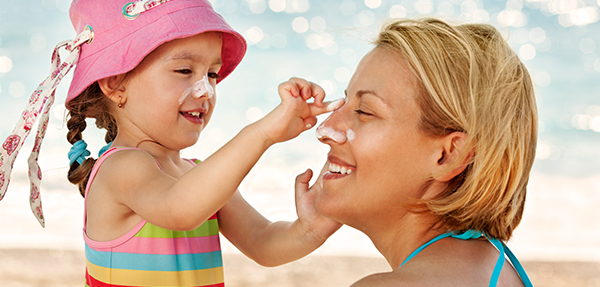Sunscreen Buying Guide

By the power of sunscreen, you can work and play outdoors without suffering from sunburn or premature signs of aging, meanwhile minimizing your risk of skin cancer. Due to increasing awareness of the importance of sunscreen, it’s now ubiquitous, available as the classic white lotion and present in everything from makeup to moisturizer to clothing.
Yet with so many different types of sunscreen in varying SPF levels available, it’s tough to know which is the most effective for your skin. Answering a few simple questions can guide you to the best ‘screen for you.
What Am I Doing Today?

Taking care of kids!
Try a mineral-based sunscreen, as ingredients like zinc oxide and titanium dioxide effectively shield against rays and tend to be gentler on sensitive skin. Spray-on sunscreens are easy to apply and dry quickly, so kids don’t have to wait as long to start having fun.

Swimming!
You’ll want water-resistant sunscreen, and you’ll want to reapply it often. According to the FDA, sunscreen is “water resistant” when it stays effective after 40 minutes in the water and “very water resistant” after 80 minutes.

Sunbathing!
Cream lotion is great for full-body coverage, and it’s easy to measure out enough to be fully covered. You’ll need approximately one ounce, or about a shot glass full of lotion.

Something active!
Try a gel, which dries fast and is easy to apply to hairy areas like your legs, arms, or chest. Even active formulas, developed to last through sweat and Herculean feats of strength, need frequent reapplying.

Heading into work!
Many daily moisturizers and foundations include sunscreen, which makes them simple to incorporate into your daily routine. Lightweight, oil-free formulas work well on delicate facial skin. If going out throughout the day, whether running errands or eating lunch outside, be sure to reapply.

Should I Use Physical or Chemical Sunscreen?
Ultimately, it depends on your preference. Check out our list of pros and cons for both physical and chemical formulas.
Physical Sunscreen
How does it work? Physical sunscreens actually block UV rays from coming into contact with your skin.
Common ingredients: zinc oxide, titanium dioxide
Considerations:
- It’s gentle on sensitive skin types, particularly skin with rosacea or eczema concerns
- Both zinc oxide and titanium dioxide are noncomedogenic, which means they don’t clog pores
- The thicker white formulas can be tough to blend into skin and may still show, particularly on dark skin
Chemical Sunscreen
How does it work? Chemical sunscreens absorb UV rays once they’ve hit your skin.
Common ingredients: para-aminobenzoic acid (PABA), avobenzone, cinoxate
Considerations:
- Chemical sunscreens usually also contain zinc oxide and titanium dioxide, but in micronized particles small enough to vanish on your skin
- Creamy formulas can soothe dry skin while they protect it from sunburn
- Once they’re absorbed, they’re invisible even on dark skin tones
- They may dry out or aggravate sensitive skin

Which SPF Should I Use?

You should pick a minimum SPF level based on your skin type and wear this minimum SPF for incidental sun exposure. Fair- to medium-skinned individuals should apply a minimum of SPF 30; darker skin tones should apply SPF 15+.
If you plan on being outside or near a window often during the day, you should increase your SPF level. Medium to dark skin tones should apply at least SPF 30, while fairer skin tones should apply SPF 45+.
Does higher SPF mean stronger protection? Yes, but as the SPF number climbs, you get diminishing returns on your UVB protection. For instance: SPF 15 sunscreen blocks 93% of UV rays, SPF 30 blocks 97%, and SPF 50 blocks up to 98%.
What is broad-spectrum sunscreen? Broad-spectrum sunscreens are key to skin-cancer prevention, and they help you maintain your skin’s health and youthful appearance. They protect skin from both UVB and UVA rays. While UVB rays are responsible for sunburn, UVA rays cause premature signs of aging like wrinkles and age spots. Both types are harmful and can lead to skin cancer. Look for sunscreens, whether physical or chemical, with a mention of broad spectrum on the label.
When Should I Wear Sunscreen?

Short answer: always.
Know when to apply: Peak sun hours are 10 a.m. to 4 p.m. For best results, put on a coat of sunscreen 15–30 minutes before sun exposure. Reapply approximately every two hours.
Use any time you’ll be outdoors: You’re exposed to harmful UVA and UVB rays any time the sun is in the sky, even when it’s cloudy or cold.
And any time you’re by a window: Rays can pass through glass, so you can still burn or experience sun damage while driving or sitting near a window.
Be careful in snow and on the water: UV rays reflect off of both, so make sure to apply (even under your chin) before you go skiing.
No sunscreen is all-powerful. Sunscreen can protect you from most but not all harmful UVA and UVB rays. Be smart about how long you stay in the sun even when you’re fully slathered.
Which Type of Sunscreen Is Best for My Skin?

Once you’ve picked a sunscreen type and SPF level, you can go even further to ensure you love your ‘screen.
For oily skin types: Try a lightweight, water-based formula with ingredients like silica or isododecane, which help absorb oil rather than add to it with plant extracts or fatty acids.
For dry skin types: Try a moisturizing sunscreen with ingredients like lanolin, dimethicones, or other oils.
For fair skin: It's all about consistent coverage. Be sure to reapply frequently, especially if you're being active.
For dark skin: Chemical sunscreens blend easily into all skin types to provide invisible coverage (physical sunscreens can appear chalky on dark skin).
For mature skin: Look for ingredients such as retinol, peptides, and plant extracts, which may stimulate collagen production and even out skin tone. Antioxidants can also help to reduce lines and spots.